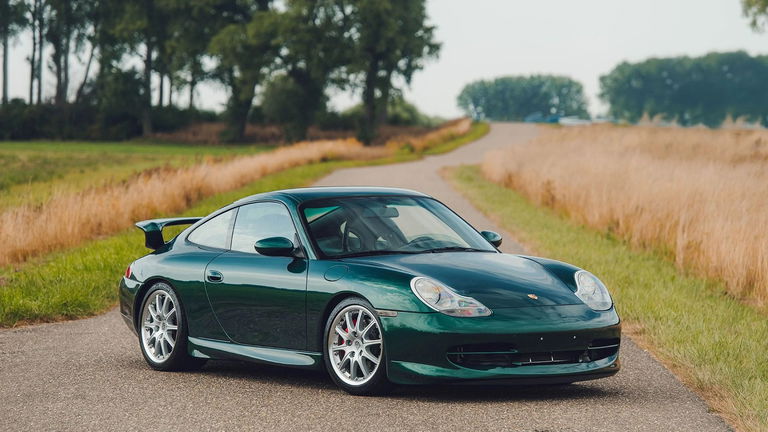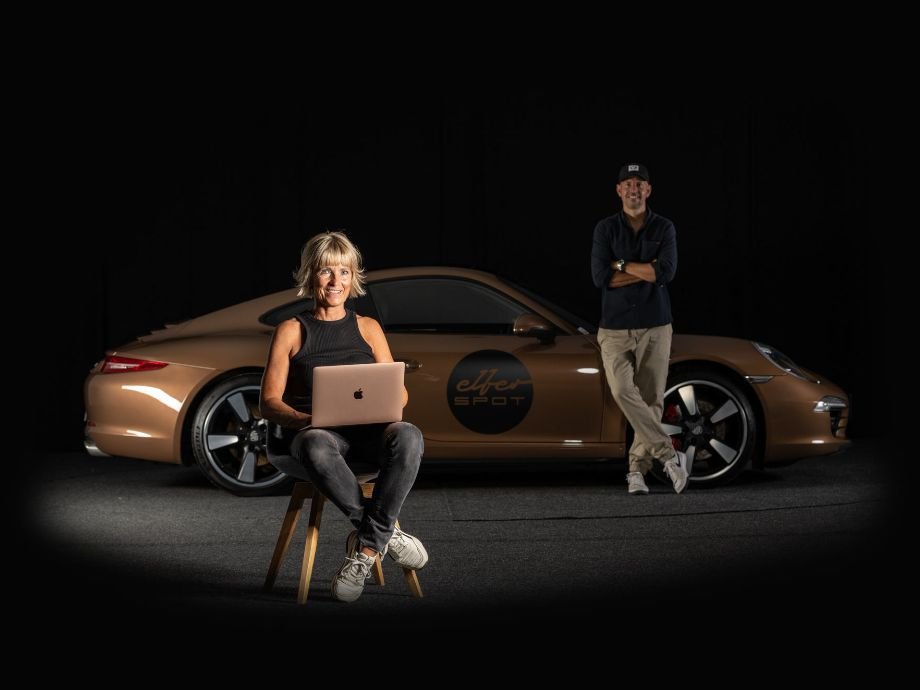Looking back, the classic cars that have risen most significantly in value tend to be defined by a recognisable set of qualities. The Porsche 911 2.7 RS is a perfect example. Just 25 years ago, you could buy one for under €50,000.
What made – and still makes – the 2.7 RS a collector’s favourite? It had a unique design, often offered with bright colours. It was the first of the RS models, uncompromising and analog, and it was produced in relatively low numbers.
The parallel to the 996 GT3 is clear. The 996 GT3 was the first to carry the now-iconic “GT3” badge — just as the RS name debuted with the 2.7 RS. After the 2.7 RS established the RS lineage, the 996.1 GT3 started the GT3 legacy. Notably, the 996.1 GT3 remains the only GT3 model never offered in a more extreme RS version, making it a true one-off in the GT3 lineage.
When it launched, the 996 GT3 upset some of the more conservative voices in the Porsche world. It featured water cooling and — perhaps most controversially — a completely new headlight design that broke away from the classic 911 look. However, if you listen to the chorus of younger generations on YouTube today, you’ll find their love for the 996 model is growing strongly, with many praising its unique character and performance. Times change. And future appreciation is driven by tomorrow’s enthusiasts and collectors, not yesterday’s purists.
I was born in 1984, long after the debate over the 911 replacing the 356. And our generation doesn’t have a strong preference between air and water cooling. I own a 1977 Carrera 3.0 and love it — I’m also a huge fan of the water-cooled models. I appreciate both, and I don’t hold any outdated or snobbish opinions about cooling systems or headlight design. In fact, I see water cooling as a positive — it enabled the development of the legendary Mezger engine and significantly more power from a naturally aspirated engine, with a glorious intake sound to match.
Another critical point is production numbers. Only 1,580 examples of the 2.7 RS were made, about the same as the 1,868 units of the 996.1 GT3. By comparison, the 991.2 GT3 saw nearly 10,000 units produced — and the production numbers of the 992 GT3 are still unknown, but almost certainly higher. Limited production is something only the early GT3 models can claim.
So what will the next 20 years bring for the 996 GT3? Time will tell, but all the ingredients are surely there.
In a brilliant video with Chris Harris and Andreas Preuninger, covering all GT3 generations up to the 992, Preuninger explains that he drove many kilometres in the 996 GT3 — it was the foundation for all GT3s that followed. Chris Harris praised the car but noted two shortcomings on track: it could use more horsepower and stronger brakes. Manthey Racing made a solution for this, and this car benefits from it.
It has been upgraded with a full Manthey K400 kit, including a freer-breathing exhaust and carbon air intake, boosting power and sharpening throttle response. On the braking side, it features a Manthey big brake kit with 350 mm rotors and six-piston calipers — a substantial improvement over the factory setup. Combined with a bespoke Manthey suspension system, a single-mass flywheel, and precision gearbox upgrades, this car represents the very best of what Manthey Racing had to offer for the 996 GT3.
In 1996, Olaf Manthey founded the company we now know as Manthey Racing — today owned by Porsche. Olaf was a successful racer, and the first winner of the Porsche Carrera Cup in 1990. A close partnership with Porsche soon followed.
In 1999, Manthey Racing debuted at Le Mans and won the GT class with their 996 GT3 R. The experience gained from these race cars was transferred to road-going models, and around 2003–2004, Manthey launched their first performance kit for the GT3 road cars — boosting power from 360 to 400 hp.
Today, the Manthey kit is a central part of GT3 history. In fact, Porsche now offers the current 992 GT3 with the Manthey kit installed from the Porsche dealerships.
So a 996 GT3 fitted with a Manthey kit should not be compared to aftermarket tuning parts from other brands. Manthey is part of Porsche’s DNA. Historically, it is one of the few names — like RUF — that actually increases a car’s value.
Enough about future value – now, let’s talk about the car itself.
I’ve owned it for two years. Before that, it lived most of its life around Cologne with a true enthusiast who cherished it for over 20 years. This was his pride and joy – lovingly maintained, never abused.
When buying a car like this, you want the right upgrades – the rare and desirable ones – but not a car that’s spent its life being hammered around racetracks. That’s what makes this example so special: it has all the incredible Manthey Racing upgrades, yet it has seen very few kilometers since they were fitted. As the previous owner put it:
“The car was incredible, but I loved it too much to really push it on track.”
So you get a car with the perfect components – still fresh and tight.
The car has the following Manthey Racing upgrades:
(All prices listed are from 2011 – actual value today is significantly higher)
• Manthey K400 Kit – complete exhaust system from manifolds out, carbon intake with Cup car filter, MM Motronic engine management. Saves 6.7 kg of weight and delivers one of the best induction sounds I’ve ever heard. (€10,800)
• Manthey Cooling Air Kit – aerodynamic slits cut into the front bumper, underbody closed. Improves brake cooling and increases front downforce by 15 kg. (€1,708)
• Manthey Adjustable Suspension Kit – developed with KW. (€4,382)
• Manthey Uniball Strut Top Mounts – improved straight-line stability, adds 1° of caster. Fully adjustable for ride height, camber, toe, and corner weighting. (€1,142)
• Manthey Sport Brake Kit (Front) – 350 mm ventilated discs with 6-piston calipers (standard 996 GT3 has 330 mm discs and 4-piston calipers). (€3,000)
• Manthey Steel-Syncro Gearbox Rebuild (€4,400)
• Manthey Steel Braided Brake Lines
• Single-Mass Flywheel
• Sports Clutch
• Short Shifter
• Cup-Style Gearshift Cable
• Heigo Roll Bar
This list is long – and expensive. Best of all, the car has covered very few kilometers since all these parts were installed. There’s even a Manthey invoice showing that Olaf Manthey himself did the suspension setup.
I’m very skeptical and detail-oriented when buying cars myself, so I was pleased to buy from exactly the right kind of seller. I’ve also done a thorough check of the car’s history, and below is a compiled overview of the documents that confirm the mileage over the years:
Service History & Documentation
• Porsche Zentrum Köln – Service book stamp – 13.03.2001 – 20,710 km
• Porsche Zentrum Dortmund – Warranty certificate – 05.01.2004 – 35,476 km
• Porsche Zentrum Dortmund – Service book stamp – 05.01.2004 – 37,568 km
• Porsche Willich – Purchase invoice – 03.08.2004 – 42,130 km
• Porsche Zentrum Koblenz – Warranty certificate – 06.01.2005 – 46,050 km
• Porsche Zentrum Essen – 111-point check – 24.02.2005 – 46,050 km
• Porsche Zentrum Koblenz – Service book stamp – 15.04.2005 – 46,913 km
• Manthey Racing – Invoice – 13.04.2006 – 47,855 km
• TÜV Essen – Technical inspection – 25.08.2006 – 49,463 km
• Porsche Zentrum Essen – Service book stamp – 21.09.2006 – 49,574 km
• TÜV GTÜ Essen – 28.06.2011 – 49,686 km
• Mobil 1 oil service – Engine bay sticker – 22.07.2018 – 50,181 km
• TÜV DEKRA Bochum – 27.04.2020 – 50,596 km
• TÜV DEKRA Essen – 15.07.2022 – 50,633 km
• Porsche Center Vejle – Service book stamp – 02.11.2023 – 50,665 km
The Manthey suspension was installed on 13.09.2004 and has been driven less than 10,000 km since.
Mileage and Ownership Analysis
In my assessment, the mileage history reflects an ideal ownership and usage record. In the first five years, the car covered 45,000 km of the total 51,800 km, which indicates a lot of regular transport use. The upgrades were carried out between 2004 and 2006, and after the upgrades, the car has done relatively few kilometers – but has been used regularly, which is good for the car – all of this is very well documented.
The previous owner had the car for over 20 years, and the consistency of the records strongly supports the authenticity of the current mileage. Many low-mileage cars have major gaps in documentation, but this example is thoroughly documented.
The car has currently driven 51,814 km. When I took ownership, I fitted new tires. The ones that were on the car dated from 2007, but had tread depth like new – another indication of the car’s minimal use.
Condition and Authenticity
The car has never been in an accident, well documented with pictures all the important places. The overall condition is excellent. This is a truly fine example of the legendary 996 GT3, in what I believe is the ideal colour, with the right upgrades.
I work in the banking industry, and I offer full financial security, honesty, and transparency throughout the transaction.
Included with the Car
• All three original keys
• Fully stamped service book
• Extensive documentation folder
• Original air filter and exchaust
The car naturally has matching numbers, confirmed in writing by Porsche Denmark












































